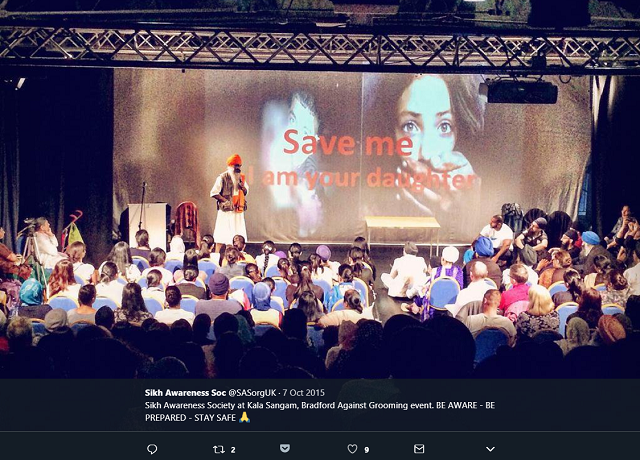Misused Trust: A story of Islamophobia, patriarchy and vigilantism Comment
New in Ceasefire, Politics - Posted on Thursday, August 17, 2017 15:17 - 0 Comments
By Katy P. Sian

A 2015 tweet by the Sikh Awareness Society, promoting film screenings of ‘Misused Trust’.
That UK media regulator Ofcom has received a complaint about the film Misused Trust, which recently aired on the Birmingham-based cable TV Sikh Channel, is welcome news. The Birmingham Mail reported that the Sikh Channel has been accused of encouraging Sikh victims of grooming to take vigilante action instead of reporting it to the police. The channel has form on this: Only last year, Ofcom ruled that it was in potential breach of its rules because of “material which glorified acts of murder.”
The film Misused Trust first came to my attention in March this year, when a friend of mine, based in the US, sent me a screenshot of Sikh Youth UK tweet promoting its release in April. Misused Trust tells the classic Sikh ‘forced’ conversions narrative, a subject that my research has now critically examined for a decade (Sian 2011, 2013). This narrative is based on an Islamophobic fantasy which suggests that there is a coordinated campaign by Muslims to capture, coerce and convert vulnerable Sikh girls into Islam. Despite its far-fetched nature, it has become a sort of obsession for some members of the Sikh community. Broadly defined, this narrative is structured along the following lines:
- Sikh girl is away from home and family, as she goes to university or college. She gains her independence/freedom and starts to go out drinking and clubbing.
- Muslim man, disguised as a Sikh, befriends her. He uses a Sikh name or wears the Kara, and even drinks, so as to fool the girls into thinking that he is Indian or Sikh. According to this type of narrative, the Muslim man is motivated by an explicit incentive: for every girl he converts there is a cash prize and — despite the drinking — a secured place in heaven.
- The couple form a relationship where the girl is ‘groomed’. They fall in love and, once she’s emotionally attached, he reveals his true Muslim identity. The cracks begin to show as she is being pressured to convert to Islam, family ties are cut, she is trapped.
- She tries to escape but compromising photos have been taken of her to use as blackmail, or she is impregnated, and thus can not risk shaming the family
- She is then beaten-up, or taken to Pakistan to work as a prostitute. No one knows of her whereabouts…
Although there are some adjustments to this outline in Misused Trust, the Islamophobic, sensationalist narrative structure largely remains the same. In this version, the filmmakers offer a ‘happy’ ending: Members of Sikh community, specifically Sikh males, are depicted as brave heroes saving the vulnerable Sikh girl by violently attacking the Muslim abuser and, later, settling her back into the Sikh community.
My research, based on interviews with members of the Sikh community, confirms that this Islamophobic myth is hegemonic within the British Sikh diaspora. It continues to circulate despite being based on flimsy evidence — largely peddled by far-right organizations — and its many contradictions, notably the paradoxical image it paints of the Sikh female. On the one hand, Sikh girls are articulated as being vulnerable, helpless and defenceless — damsels in distress in need of male protection — and yet, on the other hand, we also see them represented as independent, modern and liberated. Underlying this contrast is a clear warning: too much female agency is dangerous. It is upon this notion that a discourse that is both Islamophobic and misogynistic is constructed (ibid).
 The moral of this story seems to be that Sikh females who transgress — by embracing the western lifestyle — are more susceptible to the ‘workings’ of Muslim ‘predators’ who are secretly financing the seduction and brainwashing of Sikh girls by young Muslim men (ibid). This tale has a phantasmagorical structure which works to both reproduce historical antagonisms between Sikhs and Muslims, (by invoking the history of Mughal-era conflicts and 1947 partition violence) and rescue the Sikh community from moral decay. As such, it re-engages, stabilises and regulates the community through the articulation of a Muslim threat which operates to cast an extravagant projection of fears onto the Sikh female body (ibid).
The moral of this story seems to be that Sikh females who transgress — by embracing the western lifestyle — are more susceptible to the ‘workings’ of Muslim ‘predators’ who are secretly financing the seduction and brainwashing of Sikh girls by young Muslim men (ibid). This tale has a phantasmagorical structure which works to both reproduce historical antagonisms between Sikhs and Muslims, (by invoking the history of Mughal-era conflicts and 1947 partition violence) and rescue the Sikh community from moral decay. As such, it re-engages, stabilises and regulates the community through the articulation of a Muslim threat which operates to cast an extravagant projection of fears onto the Sikh female body (ibid).
Indeed, tales of Sikh men being abducted or ‘brainwashed’ are unheard of, which seems to suggest that the honour of the Sikh community is inscribed on the body of Sikh females. The ‘forced’ conversions narrative therefore not only reinforces ideas of what Sikh women in the community ‘should’ represent (i.e. honour, chastity, virtue and so on,) but it also reinforces indirectly the role of the Sikh male in the community. In other words, because Sikh women are at the core of this tale, Sikh men become the ‘protectors’ — who themselves can not be harmed by the ‘outsider’ (Muslim). The myth places them in a more dominant position whereby they are able — indeed, entitled and expected — to exert control over Sikh female bodies (ibid).
Sikh groups, such as Sikh Youth UK and Sikh Awareness Society, are heavily involved in the circulation of this toxic narrative. It is alarming that Sikh societies across British university campuses — including Brunel, Nottingham and Coventry — have screened this film to students, especially when Sikh Youth UK associates itself with Tommy Robinson, Britain’s most notorious far-right extremist. The film has also been screened across Gurdwaras (Sikh temples) with post-screening talks often hosted to discuss the issue of Muslim groomers.
It is even more frightening that there is an attempt to actively propagate this message of hate to North America. In 2014, I conducted further research in the US and Canada, speaking with young Sikhs. I still remember the chilling words of one particular 19-year-old Sikh female student, who told me:
“I feel like the emphasis is always on Muslims. Here, in my community and at my Sikh camp, Sikhs from England came to give us some talks, and they’d talk about how Muslims in England try to convert Sikh girls, and take their identity. But here in America I feel like its not that bad as it is in England. Here Muslims understand who Sikhs are and everyone respects each other more, and so when we heard about this stuff going on in England we were so shocked…they told us stories of Muslims putting a date rape drug in the Sikh girl’s drink, or blackmailing her. But here I don’t think anything like that happens here, I’ve never heard or read anything like that happen. I mean hearing those things from England made me scared and it made my mom scared, too, and she was like ‘stay away from Muslims. because look what they do to Sikhs girls in England’. A lot of the older generations in America are aware of this story because the Sikhs that came from England reached out to the community about this. I mean it’s not happening in America but we hear that it happens a lot in England.”
The fact that this dangerous Islamophobic discourse is being pushed down the throats of members of the UK Sikh community is no longer sustainable, and can no longer be legitimised. It is time for us in the Sikh community to reject this narrative, which plays directly into the hands of the far right. If we are to move forward, we need to challenge the structures that allow this toxic discourse to thrive and stand together to collectively fight Islamophobia and sexism in our community and beyond.
References
Sian, K. P. (2011) ‘‘Forced’ Conversions in the British Sikh Diaspora’ South Asian Popular Culture, Vol. 9, no. 2, pp. 115-130.
Sian, K. P. (2013) Unsettling Sikh and Muslim Conflict: Mistaken Identities, Forced Conversions and Postcolonial Formations, Lanham: Lexington.



Leave a Reply